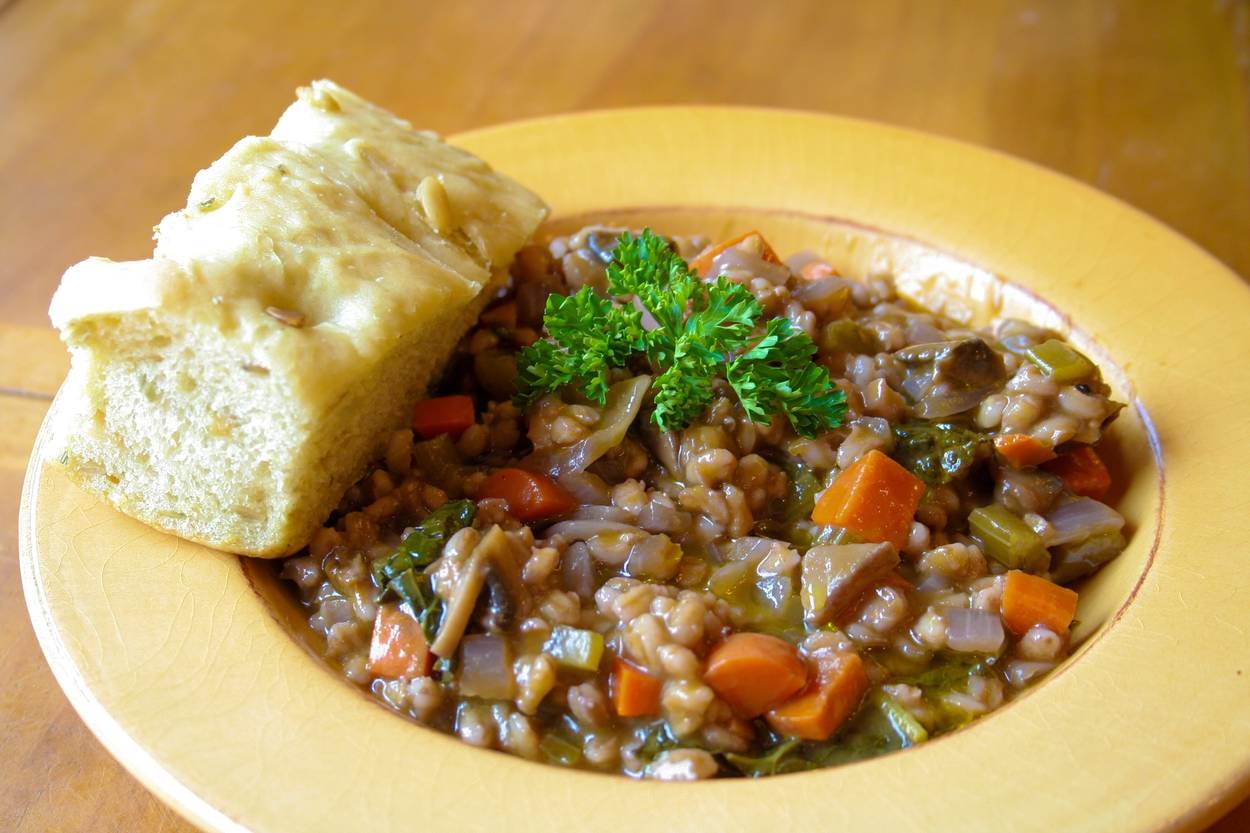When It Comes to Soup, Looks Aren’t Everything
Consider a bowl of a humble but heartwarming everyday classic: mushroom barley




Whenever I eat at B&H Dairy, the beloved, 84-year-old Jewish dairy restaurant in Manhattan’s East Village, I invariably order soup. B&H just has this way with soup—a rainbow of comforting potages ladled from a half-dozen aluminum pots steaming behind the counter. Sometimes I go for the borscht, which is bright red and brimming with softened cabbage and potatoes. Other times it’s the vegetarian chicken soup with floating, slippery noodles and a pillowy matzo ball. But when it’s especially blustery outside or I am in need of some soulful restoration, I invariably choose mushroom barley. Thick and savory with nibbles of tender grain, that soup is the equivalent of pulling on a cozy sweater and falling into a great hug.
Mushroom barley soup is not a holiday-specific dish, and therefore is rarely touted as a titan of Ashkenazi Jewish cuisine. And yet it is undeniably part of the culinary canon. Along with split pea soup, lentil soup, and creamy potato soup, it is one of the simple, inexpensive, nourishing dishes that sustained Eastern European Jews (and their non-Jewish neighbors) for generations. According to Gil Marks’ The Encyclopedia of Jewish Food, “In some households, it was eaten on a daily basis.”
Barley is one of the world’s most ancient cultivated species. Long before potatoes were introduced to Eastern Europe from the New World, barley was one of the region’s most important starches. So it is perhaps not surprising that the real soul of mushroom barley soup is the barley, not the mushrooms. This fact is reinforced by the dish’s Yiddish name, krupnik, which stems from the archaic Slavic word for hulled and polished grains, krupa. (Fittingly, the name krupnik also refers to an old-fashioned Polish cordial brewed with grain-based vodka, honey, and spices.)
While many recipes for krupnik do indeed include mushrooms, they were not always ubiquitous. In Jewish Cookery, a classic Jewish American cookbook written by Leah Leonard in 1949, the krupnik recipe includes leeks, carrots, and turnips, but noticeably not mushrooms. Mildred Grosberg Bellin’s The Jewish Cook Book from 1941 includes four barley soup recipes (plus a barley-based cholent), only one of which contains mushrooms. And even in contemporary, non-Jewish versions of the recipe, mushrooms are considered optional.
And yet there is a reason why, over time, mushrooms became an integral part of the soup’s identity, particularly in the United States. Part of it had to do with iconic Jewish restaurants like the Second Avenue Deli and Ratner’s, which flavored their barley soups with mushrooms and helped to standardize the duo. But it more than likely started with home cooks. Mushrooms grow in wild abundance across Eastern Europe, and were an important source of nourishment that could be gathered for free. “The best foragers, often peasant women, would gather extras after a rain spell and sell them at markets,” writes Liz Alpern in The Gefilte Manifesto cookbook.
Since krupnik was an everyday dish for Jewish families, many recipes did not contain meat—both because of the added expense of using flanken, and also so the soup remained pareve (and therefore more versatile from a kosher perspective). Without the meat to provide a base of hearty, umami flavor, mushrooms—particularly dried mushrooms—became the logical stand-in.
According to Alpern, dried porcini mushrooms were commonly used in Eastern Europe, and were an ingredient found in the United States as well. Jewish immigrants to America drew comfort from finding their beloved fungi in their new home. But since foraging on the Lower East Side proved next to impossible, many balaboostas purchased their mushrooms from street peddlers described by historian Jane Ziegelman in the Forward as typically an “older gentleman who roamed the streets bedecked with dried mushroom garlands around his neck,” and was “distinguished by the fact that he also wore edible ‘bracelets,’ bands of dried mushrooms that went up his arm.”
When making mushroom barley soup at home, I tend to fall into the nonmeat camp. Meaty krupniks cross too far into cholent territory—too fancy for daily consumption and, for those of us who keep kosher kitchens, robbed of the greatest pleasure that comes along with meat-free soups: a hefty dollop of sour cream bobbing on top. I also take great care to construct a flavor profile that maximizes the dish’s comforting appeal. Too many mushroom barley soup recipes have gone the way of gummy porridge, thickened with a cornstarch slurry and lacking in any distinctive flavor. But a well-made mushroom barley soup is transformative.
My go-to recipe, which I developed for The Jewish Cookbook, takes a few creative liberties from more traditional versions. To the mushroom base (I use dried porcinis plus sliced fresh creminis), I throw in some chopped fresh thyme, a little soy sauce for extra oomph, and a splash of cider vinegar to brighten things up. Even with the modern additions, it is a rather homely soup—a reminder that looks aren’t everything. As Claudia Roden writes about mushroom barley soup in The Book of Jewish Food, “It looks very unappealing, but it is heartwarming in winter.” Amen, and pass the sour cream.